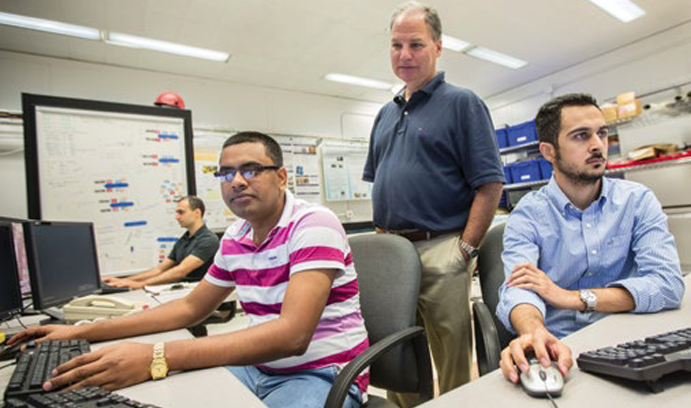A Real-Time, Hybrid Solution to Structural Testing

Ricles (center) and his students made three presentations on RTHS at the Sixth World Conference on Structural Control and Monitoring in Barcelona in July.
Engineers seeking to design structures that withstand earthquakes with minimal physical damage have a valuable new testing tool at their disposal thanks to researchers with the George E. Brown Jr. Network for Earthquake Engineering Simulation (NEES).
During a four-year project, says Jim Ricles, professor of structural engineering, the NEES team validated Real-Time Hybrid Simulation (RTHS) as an “efficient and economic” method of testing a structure’s ability to sustain the complex, dynamic loads of an earthquake.
RTHS, says Ricles, treats a structural system as two conceptual parts—an analytical substructure represented by a numerical model, typically using a finite element method, and an experimental substructure that is modeled in a lab.
An RTHS test imposes “displacements” of various velocities on both substructures for each time step of a seismic event. Test results are integrated to determine the overall system’s dynamic response to earthquake forces.
“At each time step,” Ricles’ group wrote in Earthquake Engineering and Structural Dynamics, “the inertia, damping and restoring forces of the analytical substructure are formulated numerically [and] measured physically for the experimental substructure.”
Conventional hybrid tests impose displacements on an experimental substructure in “an extended time scale,” the researchers wrote. An RTHS test imposes them in real time, enabling researchers to obtain more realistic results.
Ricles’ collaborators at Lehigh include Richard Sause, professor of structural engineering; Ph.D. candidates Karim Kazemi Bidokhti, Chinmoy Kolay, Akbar Mahvashmohammadi and Baiping Dong; Yunbyeong Chae ’11 Ph.D.; and Thomas M. Marullo, NEES IT manager.
The group tested a three-story prototype building made of reinforced concrete and a multistory steel structure with nonlinear viscous dampers. Research partners for the second project included California State University at Northridge, California State Polytechnic University, Penn State University at Erie, Corry Rubber Co., and Taylor Devices. Tests were conducted at Lehigh’s NEES Real-Time Multi-Directional Earthquake Simulation Facility, one of the world’s largest.
Founded by NSF in 2004, NEES is a collaboration of 14 American research institutions. NEES researchers, says Ricles, NEES principal investigator at Lehigh, have completed 20 major RTHS projects and performed nearly 2,000 large-scale, real-time tests. An RTHS test can be parceled up, with researchers at separate sites conducting different portions of the experiment.
Posted on:

